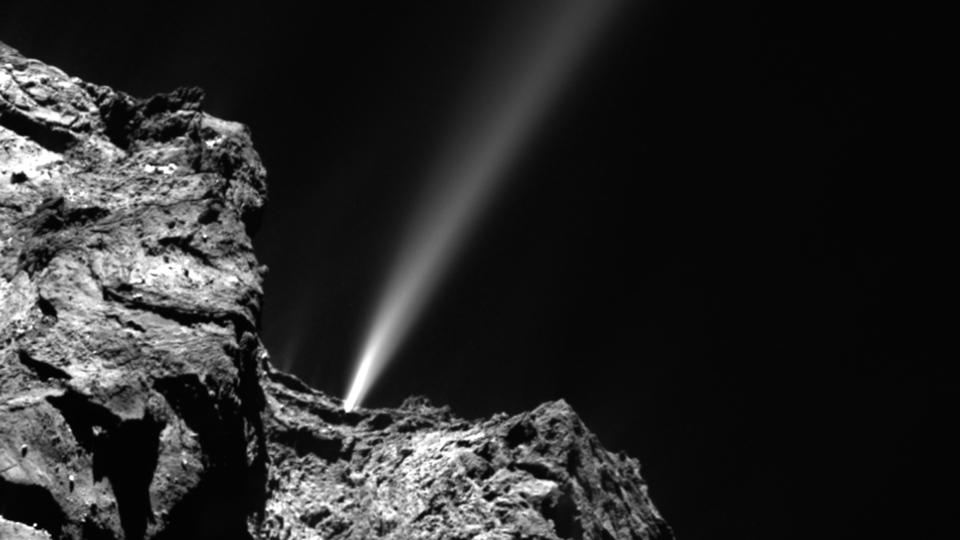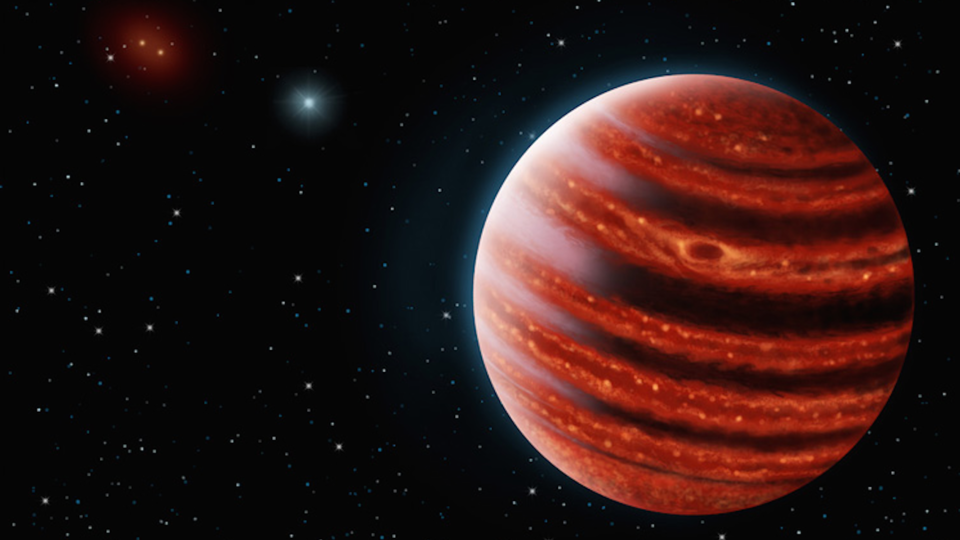Science News
Space Friday: Lettuce, 67P, and a Young Jupiter
Space Lettuce
“It was one small bite for man, one giant leap for #NASAVEGGIE and our #JourneytoMars. #YearInSpace,” tweeted Astronaut Scott Kelly this past Monday when he and two other crew members onboard the International Space Station took the first bite of lettuce grown in space. While vegetables have been grown in space stations before, this marks the first time crew members were permitted to consume the “veggies of their labor.”
On July 8, Kelly activated the lettuce seeds that had been hibernating in the Veggie-01 plant growth system for the past 15 months. The collapsible and expandable system utilized red, blue, and green LED lights because while red and blue are the most efficient at stimulating plant growth, the result would have been purple lettuce leaves (Earth plants receive white light from the Sun exposing them to a mix of red, blue, and green). So, green LEDs were added to give the plant a more appetizing, Earth-like color. After waiting 33 days for the plants to mature, the astronauts cleaned the leaves with citric acid-based, food safe sanitizing wipes before eating them. A portion, of course, was bagged and frozen for future lab study back on Earth.
Experiments such as these are critical to sustaining long-duration human missions, such as proposed journeys to Mars. A round trip to the Red Planet would take at least two years without resupplies, so the ability for astronauts to grow their own food is invaluable.
“Having lived on the space station for a while, I understand the logistical complexity of having people work in space for long periods and the supply chain that’s required to keep us going,” Kelly noted. “If we’re ever going to go to Mars someday, and we will, we’re going to have a spacecraft that is much more self sustainable with regard to its food supply.”
Growing space crops is not just a matter of supply for a long voyage—astronauts gain additional health and psychological perks as well. “There is evidence that supports fresh foods, such as tomatoes, blueberries and red lettuce, are a good source of antioxidants. Having fresh food like these available in space could have a positive impact on people’s moods and also could provide some protection against radiation in space,” notes Ray Wheeler in NASA’s press release. Kelly seems to agree: “It’s wonderful to eat fresh food on the ISS, which is a lot of white and aluminum and it’s kind of a sterile environment. It’s really fun to see green, growing things in here that we’re intentionally growing for sustenance.”
Of course, the benefits of the experiment hit a little closer to home than just supplying future space travel. The breakthrough technology implemented in growing produce in an artificial environment could provide insight on how to do the same in areas here on Earth using artificial light or minimal water. –Elise Ricard
Rosetta’s Comet at Perihelion: A Super-Outburst and the Origin of the “Ducky”
Wow! Back at the end of July, only weeks before its closest approach to the Sun, Comet 67P/Churyumov-Gerasimenko let loose with a short-lived, but stunningly-bright jet of gas that was captured by the orbiting Rosetta spacecraft. According to the European Space Agency, this 18-minute eruption was so powerful that it “pushed away the incoming solar wind,” the constant stream of solar particles that sculpts a comet’s tail into a long, glowing streamer of dust and gas.
Normally, the jets are so tenuous and faint that image contrast must be stretched to make them visible, overexposing the image of the comet’s nucleus and washing out details. In this case, however, the jet shone brighter than the nucleus itself and was easy to image. Following the outburst, instruments aboard Rosetta detected changes in the structure and composition of the coma (the cloud of material surrounding the nucleus): carbon dioxide content doubled, methane quadrupled, and hydrogen sulfide (the stinky gas that makes rotten eggs smell the way they do) increased by a factor of seven.
Concentrations of dust also increased, jumping from one to three particle detections per day to 30. Dust is the reason Rosetta can’t orbit too close to the comet to hunt for its wayward Philae lander—the flurry of particles can confuse the spacecraft’s navigation system, which must steer by orienting on bright stars. Spacecraft controllers will have to wait for surface activity to subside after perihelion before they can attempt to safely approach the comet again.
In other 67P-related developments, scientists have been trying to come up with explanations for 67P’s unusual, “rubber duck” shape, but astronomers are doubtful that the shape is the result of unusual erosion limited only to the narrow “neck” region. Since similar structures on the comet don’t seem to be consistently aligned across both the “head” and “neck,” researchers conclude that 67P is most likely a “contact binary,” resulting from the fusion of two colliding bodies. A series of near-parallel cracks found in one area could be evidence of a past collision. Whether the two objects that eventually merged into the “ducky” formed separately or were both part of a larger comet that broke apart is yet to be determined. Scientists are very excited to have a ringside seat—if 340 kilometers (210 miles) away can be considered ringside—as 67P now undergoes its most active phase.
Suspected examples of contact binaries in and outside of our solar system include other comets, several asteroids, and even stars that have a bi-lobed or “peanut” shape. –Bing Quock
Young Jupiter Discovered
“Judging by its low luminosity, low temperature and strong methane signature, this is the most Jupiter-like exoplanet ever directly imaged.” That’s UC Berkeley’s James Graham, project scientist for the Gemini Planet Imager (GPI), describing the first planet detected by GPI—51 Eridani b, located about 100 light-years from Earth in a triple-star system that’s only about 20 million years old.
The GPI instrument—the size of a small car—is mounted on the 8-meter Gemini South telescope in Chile. It was designed, built, and optimized for imaging and analyzing the atmospheres of faint Jupiter-like planets next to bright stars, thanks to a device that masks the star’s glare.
“This is exactly the kind of planet we envisioned discovering when we designed GPI,” Graham explains. “We wanted to find planets when they’re young so we can figure out the formation process.”
20 million years is quite young, cosmically speaking. When young planets coalesce, material falling into the planet releases energy and heats it up. Over the next hundred million years the planet radiates that energy away, mostly as infrared light, making direct detection possible.
Once the astronomers zeroed in on the star 51 Eridani, they blocked its light and spotted light reflecting off 51 Eridani b, orbiting a little farther away from its parent star than Saturn does from the Sun. The light from the planet is very faint—more than three million times fainter than its star—but GPI can see it clearly. (The other two stars in the system form a close pair far from the planet’s host star, and apparently do not affect the planet’s orbit.) Observations revealed that the planet is roughly twice the mass of Jupiter.
In addition to being the lowest-mass planet ever directly imaged, it’s also one of the coldest—about 430°C (800°F), whereas others are around 650°C (1,200°F)—and features the strongest atmospheric methane signal on record. Previous Jupiter-like exoplanets imaged have shown only faint traces of methane, far different from the heavy methane atmospheres of the gas giants in our solar system.
“The exoplanet 51 Eri b is the first one that’s cold enough and close enough to the star that it could have indeed formed right where it is the ‘old-fashioned way,’” says Stanford’s Bruce Macintosh, leader of the GPI survey. “This planet really could have formed the same way Jupiter did—this whole planetary system could be a lot like ours.”
Astronomers believe that the gas giants in our solar system formed by building up a large core over a few million years and then gravitationally attracting a huge amount of hydrogen and other gases to form an atmosphere. But the Jupiter-like exoplanets that have so far been discovered are much hotter than models have predicted, hinting that they could have formed much faster as material collapses quickly to make a very hot planet. This is an important difference. The core-buildup process can also form rocky planets like Earth; a fast and hot collapse might only make giant gassy planets.
The team of astronomers hopes that studying young systems like this one may shed light on the formation of our solar system. Their findings are published this week in Science. –Molly Michelson
Image: 67P/ESA, Exoplanet/Danielle Futselaar and Franck Marchis, SETI Institute

